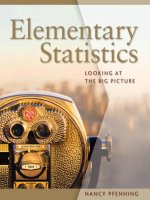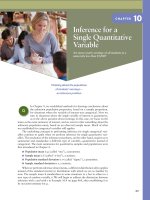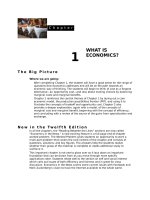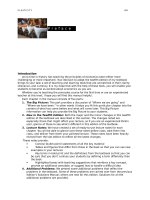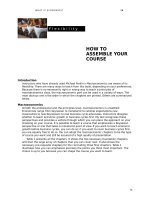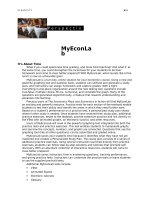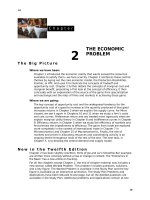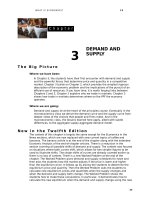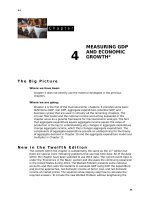The big picture marcoeconomics 12e parkin chapter 13
Bạn đang xem bản rút gọn của tài liệu. Xem và tải ngay bản đầy đủ của tài liệu tại đây (291.27 KB, 12 trang )
W H AT I S E C O N O M I C S ?
19
C h a p t e r
13
FISCAL POLICY
The Big Picture
Where we have been:
This chapter extensively uses the aggregate supply-aggregate demand model
introduced in Chapter 10. It also makes use of Chapter 11’s discussion of
multipliers. The material on the labor market and potential GDP from Chapter
6 is important when discussing the supply-side effects of fiscal policy.
Where we are going:
Chapter 14 on monetary policy completes the material on macroeconomic
stabilization policies.
N e w i n t h e Tw e l f t h E d i t i o n
This chapter is rich with data, which has all been updated to 2014. The At Issue
section has updated content while it continues to have President Obama and Paul
Ryan’s contrasting policy suggestions. The Economics in the News feature at the
end of the chapter discusses a 2014 article on Japan’s challenges with its debt and
deficit. The Worked Problem explores the short-run and long-run consequences on
economic growth and other variables of an increase in infrastructural expenditure
and a decrease in taxes. The AD-SAS model is used to answer the questions. To
include the new Worked Problem without lengthening the chapter, some problems
have been removed from the Study Plan Problem and Applications. These
problems are still in the MyEconLab and are called Extra Problems.
19
Lecture Notes
Fiscal Policy
Fiscal policy refers to changes in government expenditure and taxes.
Fiscal policy impacts both aggregate supply and aggregate demand.
I. The Federal Budget
The annual statement of the outlays and receipts of the government of the United States
together with the laws and regulations that approve and support those outlays and receipts
make up the federal budget. The use of the federal budget to achieve macroeconomic
objectives such as full employment, sustained economic growth, and price level stability is
called fiscal policy.
The Institutions and Laws
The President submits a budget proposal to Congress. Congress debates, amends,
and enacts the budget. The budget operates within the framework of the
Employment Act of 1946, which states: “… it is the continuing policy and
responsibility of the Federal Government to use all practicable means … to
coordinate and utilize all its plans, functions, and resources … to promote maximum
employment, production, and purchasing power.”
The Council of Economic Advisers monitors the economy and keeps the President
and the public well informed about the current state of the economy and the best
available forecasts of where it is heading.
Highlights of the 2015 Budget
Receipts come from four sources: personal income taxes ($1,505 billion), social
security taxes ($1,176 billion), corporate income taxes ($537 billion), and indirect
taxes and other receipts ($296 billion).
Outlays are classified in three categories: transfer payments ($2,649 billion),
expenditure on goods and services ($1,030 billion), and debt interest ($479 billion).
Budget balance = Receipts – Outlays
If receipts exceed outlays, the government has a budget surplus.
If outlays exceed receipts, the government has a budget deficit.
If receipts equal outlays, the government has a balanced budget.
The U.S. Budget in Historical Perspective and in Global Perspective
Since 1990, except between 1998 to 2001, the U.S. government has had a budget
deficit.
Government debt is the total amount that the government has borrowed. A
budget deficit adds to the government debt.
In 2014, all of the world’s major economies except Germany had a budget deficit.
The newly industrialized economies of Asia had the smallest deficits while Japan, the
United States, the United Kingdom (in that order) had the largest deficits as a
fraction of GDP. The U.S. deficit was about 5 percent of GDP.
The At Issue detail presents arguments about different budget plans. President Obama’s
plan keeps the budget deficit constant at $500 billion through 2024, while Representative
Paul Ryan’s plan would slash the deficit to $100 billion over the same time period.
Deficit and debt. Many students need help with the distinction between the deficit and
the debt (and with what happens to the debt when there is a surplus). Use the student loan
or credit card analogy. Explain that the budget balance (the deficit or surplus) is just like a
personal budget balance (the amount that a student borrows or pays back during a given
year). The debt—the total amount owed by the government—is like the balance on a
FISCAL POLICY
student loan or credit card account. Students (usually) have a budget deficit and
increasing debt. And graduates with a job (usually) have a budget surplus and decreasing
debt.
An interesting historical episode. During the mid-1830s—a long time ago—the U.S.
government had virtually repaid all its debt. At that time the government faced a problem
that doesn’t occur today: it had a surplus and didn’t know what to do with it. The decision
was made to transfer money to the state governments. Each state was to receive $400,000
in four payments of $100,000 each. The first three payments were made, but the last one
was postponed because of a recession in 1837 that lowered the federal government’s
revenue and then was never made. In the 1970s, faced with a severe budget crunch, the
State of New York sued to receive that last payment plus interest. The state lost the suit
and so the last payment probably will never be made! (You might remark that $100,000
invested in 1837 at the average interest rate would have accumulated to about $30 billion
by 2015!)
II. Supply-Side Effects of Fiscal Policy
The effects of fiscal policy on employment, potential GDP, and aggregate supply are known
as supply-side effects.
The Effects of Taxes on Full Employment and
Potential GDP
The labor market determines the full
employment quantity of labor, which,
together with the production function,
determine potential GDP.
The equilibrium quantity of employment is
determined in the labor market. The first
figure shows the labor market. In the figure
equilibrium employment is 250 billion hours
per year. This amount of employment is fullemployment.
The second figure shows the production
function. With employment of 250 billion
hours, the production function shows that
real GDP is $13 trillion.
An income tax decreases the supply of labor and shifts the supply of labor curve
leftward. In the top figure, the LS curve shifts leftward. Because of the tax wedge, the
level of employment decreases. In the bottom figure the decrease in employment
decreases potential GDP.
An income tax drives a tax wedge
between the before-tax wage rate that firms
pay and the after-tax wage rate that
workers receive. Other taxes, such as sales
taxes, add to the tax wedge by effectively
lowering the real wage rate.
Some Real World Tax Wedges … Does the Tax
Wedge Matter?
Tax wedges vary across countries, being much
higher in France than in the United States.
According to supply-side economists such as Ed
Prescott, the tax wedge has a large impact on
131
132
CHAPTER 13
potential GDP. Potential GDP per person in France is 30 percent below that in the United
States and Prescott asserts that the entire difference can be attributed to the difference in
the countries’ tax wedges.
FISCAL POLICY
Taxes and the Incentive to Save and Invest
A tax on interest income decreases the
supply of saving and shifts the supply of
loanable funds curve leftward. The tax
drives a wedge between the after-tax
interest rate received by savers and the
interest rate paid by firms. The tax does not
change the demand for loanable funds.
The figure shows the result: the real
interest rate paid by borrowers rises (from
5 percent to 6 percent in the figure) and
the equilibrium quantity of loanable funds
and investment decrease.
The decrease in investment lowers the
growth rate of potential GDP.
Tax Revenues and the Laffer Curve
The relationship between the tax rate and the amount of tax collected is called the
Laffer curve. The Laffer curve shows that at a high enough tax rate, an increase in
tax rates decreases tax revenues. Tax revenues decrease because individuals find
ways to avoid the high taxes, including by working less.
Most economists believe that taxes have an effect on the supply of labor, but that in
the U.S. economy, the tax rate is low enough so that an increase in the tax rate
increases tax revenues.
Laffer Curve and Napkins: Students get a kick out of the napkin roots of the Laffer
Curve. The story that Laffer himself cannot deny nor confirm is that he first drew the Laffer
curve on a napkin during one of his first attempts to persuade someone of his supply side
theory. Draw the Laffer curve and ask what side of the curve are we on? Ask them what
they think the highest tax rate was in the United States, they are usually shocked to learn
that we had marginal rates in the 70% range as recently as the 1970. This a great
discussion point on how high tax rates can deter work!
Consumption Tax: Students enjoy exploring the controversial idea of abolishing the IRS in
favor of a consumption tax. Whether you agree with it or not, the Fairtax plan (Google
Fairtax plan to find the website) covers many issues from this chapter and is an awesome
way to bring together many of the topics from the course. Students engage with the
concept of a revenue neutral switch from our mixed tax system to 100% consumption tax. I
assign a short paper for them to investigate one of the many sub-topics within the plan.
The Economics in the News detail compares the U.S. corporate tax rate with those in other
countries and explores how the tax wedge affects the U.S. loanable funds market.
III. Generational Effects of Fiscal Policy
Generational accounting is an accounting system that measures the lifetime tax burden
and benefits of government programs to each generation.
Generational Accounting and Present Value
To compare the costs and benefits that occur at different points in the future, which is
necessary in generational accounting, the concept of present value is used. A present value
is an amount of money that, if invested today, will grow to equal a given future amount
when the interest that it earns is taken into account. Because there is uncertainty about the
133
134
CHAPTER 13
proper interest rate to use when calculating present values, plausible alternative numbers
are used to estimate a range of present values.
The Social Security Time Bomb
Fiscal imbalance is the present value of the government’s commitments to pay
benefits minus the present value of its tax revenues. In 2014, the fiscal imbalance
was estimated to be $68 trillion and growing by about $2 trillion every year. The
fiscal imbalance is high because of obligations under Social Security laws and
Medicare.
There are four alternatives for redressing the fiscal imbalance: raise income taxes,
raise Social Security taxes, cut Social Security benefits, or cut federal government
discretionary spending. But the changes needed would be severe. It is estimated
that income taxes would need to be raised by 69 percent; or Social Security taxes
raised by 95 percent; or Social Security benefits cut by 56 percent.
Generational Imbalance
Generational imbalance is the division of the fiscal imbalance between the current and
future generations assuming that the current generation will enjoy the current levels of
taxes and benefits. It is estimated that the current generation will pay 83 percent of the
fiscal imbalance and the future generations will pay 17 percent.
IV. Fiscal Stimulus
A fiscal action that is initiated by an act of Congress is called discretionary fiscal
policy.
A fiscal action that is triggered by the state of the economy is called automatic
fiscal policy.
Automatic Fiscal Policy and Cyclical and Structural Budget Balances
Tax revenues and needs-tested spending change with the business cycle.
The government sets tax rates. As incomes vary with the business cycle, the tax
revenue collected changes. Tax revenue automatically falls in recessions and
automatically rises in expansions.
Government expenditure on programs that pay benefits to people and
businesses depending on their economic status is called needs-tested
spending. Needs-tested spending automatically increases in a recession and
automatically decreases in an expansion, helping to stabilize the economy.
Induced taxes and needs-tested spending mean that the federal budget deficit is
counter-cyclical, with the deficit increasing in a recession and decreasing in an
expansion.
The structural surplus or deficit is the budget balance that would occur if the
economy were at full employment and real GDP were equal to potential GDP. The
cyclical surplus or deficit is the actual surplus or deficit minus the structural
surplus or deficit.
In 2014 the total U.S. budget deficit was $0.64 trillion. According to the
Congressional Budget Office (CBO) the cyclical deficit was $0.18 trillion so the
structural deficit was $0.46 trillion.
The structural deficit skyrocketed after 2008..
By their nature, automatic fiscal policy implies federal budget deficits in recessions as tax
revenues fall and spending increases. By contrast, balanced budget rules for state and
local governments mean that these governments do not conduct stabilizing fiscal policy. In
the 2008 recession, the sharp decline in state and local tax revenues meant that state
spending programs had to be cut and, in some states, taxes raised. Such policies are the
opposite of the policies that can be used to help stabilize the business cycle.
FISCAL POLICY
Automatic fiscal policy helps stabilize the business cycle because it provides an
automatic stimulus during a recession and an automatic contraction during an
expansion.
Discretionary Fiscal Stimulus
The government expenditure multiplier is the quantitative effect of a change in
government expenditure on real GDP. An increase in government expenditure
increases aggregate expenditures setting in motion the multiplier process.
The tax multiplier is the quantitative effect of a change in taxes on real GDP. A
decrease in taxes increases disposable income and hence consumption expenditure,
setting in motion the multiplier process.
The effect on aggregate demand from a tax cut is less than that from a similar
sized increase in government expenditure. A $1 tax cut generates less than a $1
increase in consumption expenditure since only a fraction (equal to the MPC) of
the $1 increase in disposable income is spent on consumption expenditure.
135
136
CHAPTER 13
Fiscal Stimulus
Expansionary fiscal policy (an increase in
government expenditure or a decrease in
taxes) seeks to eliminate a recessionary
gap. If timed correctly and of the correct
magnitude, fiscal policy can be used to
push the economy to potential GDP.
The figure shows the effect of expansionary
fiscal policy on aggregate demand. At the
initial equilibrium, $15 trillion real GDP and
price level of 110, there is a recessionary
gap. The expansionary policy increases
aggregate demand and the multiplied
effect shifts the AD curve rightward from
AD0 to AD1. The recessionary gap is
eliminated and the economy moves to its
new equilibrium, $16 trillion real GDP
(which equals potential GDP) and price level of 115.
Fiscal Stimulus and Aggregate Supply
The focus so far has been on only aggregate demand. But fiscal policy also impacts
aggregate supply.
Government Expenditure: An increase in government expenditure increases the
budget deficit. The demand for loanable funds increases, so the real interest rate
rises and investment is crowded out. The decrease in investment offsets the
expansionary effect from the increase in government expenditure. The crowding-out
effect is strong enough so that the government expenditure is less than 1.
Tax Cut: A tax cut also has effects on aggregate supply. A tax cut increases the
supply of labor and the supply of loanable funds, both of which increase aggregate
supply. The supply-side effects make the tax multiplier larger than the government
expenditure multiplier.
There is quite a bit of controversy about the size of the multipliers and this controversy is
nicely covered in an Economics in Action detail. Christina Romer, while working for the
Obama administration, asserted that the government expenditure multiplier was 1.5.
Robert Barro, of Harvard University, says his research shows the multiplier is 0.5. These
differences are dramatic and students can appreciate their importance and real-world
relevance. Highlight the Ricardo-Barro effect as a possible argument for smaller
multipliers.
Limitations of Discretionary Fiscal Policy
In practice, discretionary fiscal policy is hampered by three time lags:
Recognition Lag: The recognition lag is the time it takes to figure out that fiscal
policy actions are needed.
Law-Making Lag: The law-making lag is the amount of time it takes Congress to pass
the laws needed to change taxes or spending.
Impact Lag: The impact lag is the time it takes from passing a tax or spending
change to implementing the new arrangements and feeling their effects on real GDP.
Fiscal policy in practice. Most economists acknowledge that, in principle, discretionary
fiscal policy can be used for stabilization purposes, but in practice such stabilization is
extremely difficult because of long legislative lags. It is worth reminding the students that
the equilibrium in the AS-AD model takes time to work out. The multiplier is a long drawn
FISCAL POLICY
out process. An increase in government expenditure shifts the AD curve rightward but the
new equilibrium price level and real GDP take time to occur. It is also useful to discuss the
length of time it took the Congress to pass the 2002 “stimulus package” and the time it
took in the Fall of 2008 to decide on a fiscal policy to be used after the initial “bailout
package.” The law-making lag can be substantial and the outcomes questionable!
137
138
CHAPTER 13
Additional Problems
1.
The government is proposing to lower the tax rate on labor income and asks
you to report on the supply-side effects of such an action. Answer the
following questions and describe what happens on the relevant graph. You
are being asked about directions of change, not exact magnitudes.
a. What will happen to the supply of labor and why?
b. What will happen to the demand for labor and why?
c. What will happen to the equilibrium level of employment and why?
d. What will happen to the equilibrium before-tax wage rate?
e. What will happen to the equilibrium after-tax wage rate?
f. What will happen to potential GDP?
2.
How Reagan Would Fix the Economy
Many Republicans look at Reagan’s policies in the early 1980s and assert that
tax cuts pay for themselves. That’s wrong—Reagan’s rate cuts for the rich
paid for themselves, but the tax cuts for the poor, the middle class and
corporations did not. The deficit increased. But there is a limit to the deficit.
At some time the government debt grows so large that it starts to harm the
economy through higher interest rates, bigger debt payments, a weaker
currency, etc.
Time, May 26, 2008
a. Explain why Reagan’s tax rate cuts for high income taxpayers may have
paid for themselves, but cuts for lower-income and middle-income taxpayers
did not.
b. Explain the negative consequences of running persistently large budget
deficits.
3.
Explain why extending unemployment insurance benefits has both a supplyside and demand-side effect on real GDP and the price level.
Solutions to Additional Problems
1. a. The supply of labor increases. The supply of labor curve shifts rightward. The supply
of labor increases because at each real wage rate, the after-tax wage rate received
by workers will be higher given a decrease in the tax rate on labor income.
b. The demand for labor remains the same. The demand for labor depends on the
productivity of labor, which remains the same following the decrease in the tax rate
on labor income.
c. The equilibrium level of employment increases. With the rightward shift in the supply
of labor curve, the real wage rate decreases and the quantity of labor demanded
increases along the demand for labor curve. Equilibrium employment increases.
d. The equilibrium pre-tax wage rate decreases. The rightward shift of the supply of
labor curve leads to movement down along the demand for labor curve.
e. The equilibrium after-tax wage rate increases. The decrease in the tax rate on labor
income decreases the wedge between the before-tax wage rate and the after-tax
wage rate. The before-tax wage rate decreases but not by as much as the decrease
in tax. So the after-tax wage rate increases.
FISCAL POLICY
f.
Potential GDP increases. The equilibrium level of employment is the full employment
quantity of labor. So as full employment increases, potential GDP increases along the
production function.
2. a. High-income taxpayers faced very high tax rates. For these taxpayers, the cut in tax
rates probably lead to large increases in the quantity of labor they supplied so that
the tax revenue from high-income taxpayers increased. But middle-income and
lower-income taxpayers did not face such high rates. For these groups the tax cut
increased the quantity of labor they supplied but by only a small amount so that the
tax revenue from middle-income and low-income taxpayers decreased.
b. Persistently running large budget deficits increases the government debt, which
increases the interest the government must pay and contributes to larger budget
deficits in the future. Budget deficits also crowd out investment, so persistently
running budget deficits decreases investment and the capital stock is less than
otherwise. Because the capital stock is smaller, U.S. potential GDP is lower.
3.
Extending unemployment insurance benefits increases the amount of time
unemployed workers search for new jobs, which decreases employment. The decrease
in employment decreases aggregate supply. Simultaneously extending unemployment
insurance benefits increases the income received by unemployed workers. The
increase in income increases consumption expenditure, which increases aggregate
demand.
Additional Discussion Questions
11. What is the distinction between the government’s budget deficit and
the government’s debt? The budget deficit is the amount the government is
borrowing in any given year. The government debt is the total amount the
government has borrowed over all the years. The budget deficit adds to the
(total) government debt.
12. Suppose that the government increases its expenditures payments by
$100 billion and pays for the increase by raising taxes by $100 billion.
What is the effect on aggregate demand and real GDP of each change
individually and of the two combined? The increase in government
expenditure adds directly to aggregate demand so that aggregate demand
and real GDP both increase. The increase in taxes indirectly decreases
aggregate demand by decreasing consumption expenditure. The decrease in
aggregate demand leads to a decrease in real GDP. The magnitude of the
increase in aggregate demand from the increase in government expenditure
exceeds the magnitude of the decrease from the increase in taxes. So when
both effects are combined, on net aggregate demand increases so that real
GDP increases.
13. Why does a change in income taxes have a different effect on
aggregate supply than a change in government expenditures? A
change in income taxes changes the tax wedge and affects people’s incentives
to supply labor. The supply of labor changes, which affects employment and
hence potential GDP. For example, if income taxes are boosted, the supply of
labor decreases. With the decrease in the supply of labor, employment
decreases so that potential GDP decreases. The decrease in potential GDP
decreases aggregate supply. A change in government expenditures does not
have this same incentive effect. Because it does not have this effect, it has no
impact on aggregate supply.
139
140
CHAPTER 13
14. Suppose because of a recession, most state governments experience
reductions in tax revenues, and respond by reducing their
expenditures and increasing their taxes to keep their state budgets in
balance (a constitutional requirement in many U.S. states). Will this
have any effect on the recession, and if so, what? This policy on the part
of states deepens the recession. In a recession fiscal policy generally aims to
increase aggregate demand because the increase in aggregate demand
increases real GDP. Cutting state government spending and raising taxes
decreases aggregate demand. A decrease in aggregate demand decreases
real GDP and worsens the recession.
5. In 2012, the looming “Fiscal Cliff” meant that there would be an
increase in taxes coupled with a decrease in government spending.
Meanwhile the Federal Reserve was continuing “Quantitative Easing.”
Discuss the combined effects of these events on the economy. The
fiscal cliff is a combination of two contractionary fiscal policies which would
decrease aggregate demand. Quantitative Easing is an expansionary
monetary policy meant to increase aggregate demand. Chairman Bernanke
stated during the fourth quarter of 2012 that the Fed was pursuing that policy
in part to hedge against the negative effects of the fiscal cliff should it happen.
